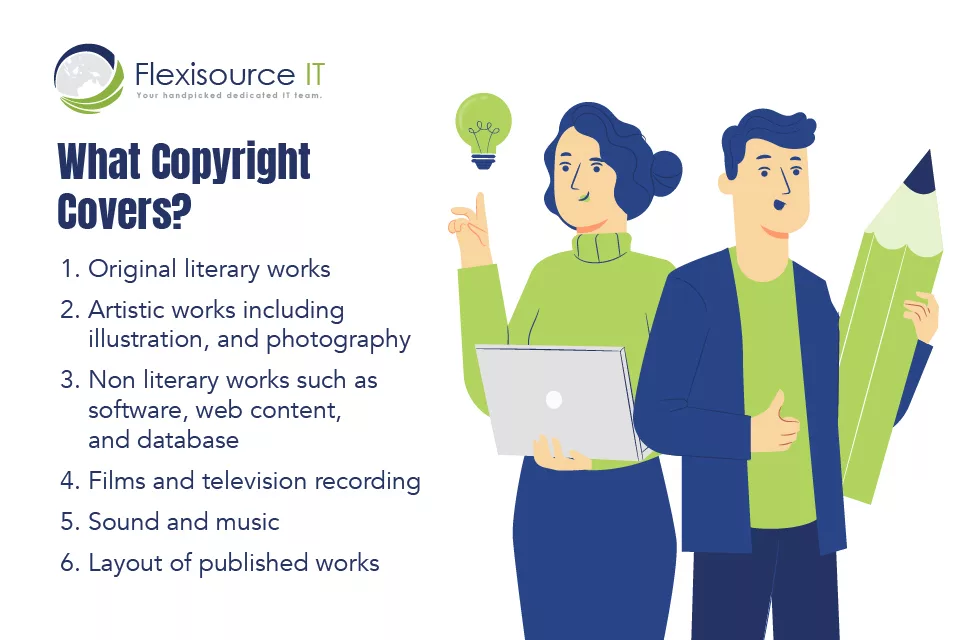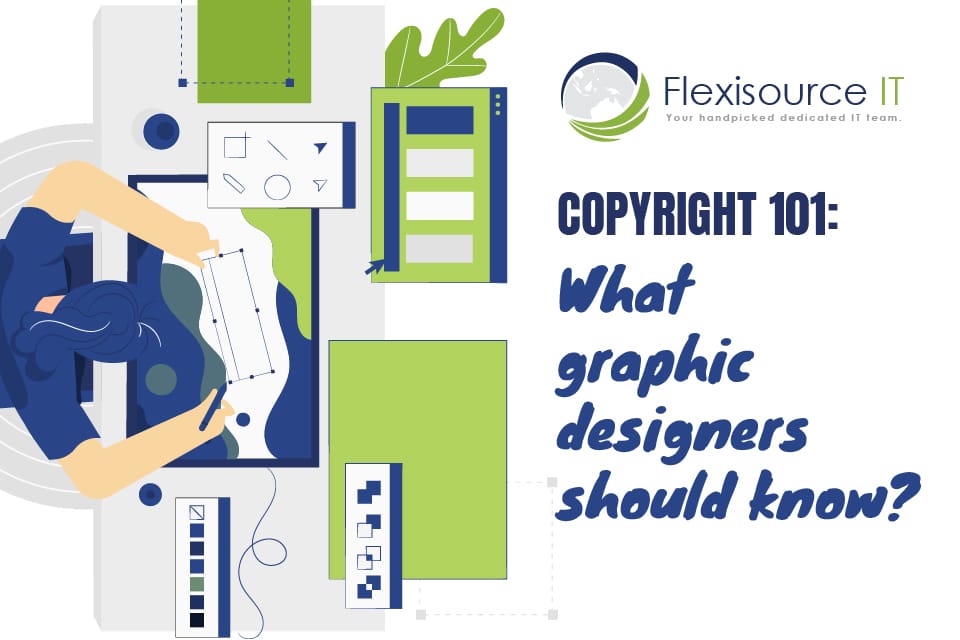For a lot of creators, inspiration is a must. Every day, you may go around the city or look around popular websites to create that perfect design and stimulate your mind. And before you realize it, you are copying someone’s work. You might think that the original work just inspires you. However, there’s a fine line between being inspired by another work and plagiarizing it.
As a graphic designer or an outsourced web designer, you are responsible for learning all intellectual property laws and copyright regulations that might affect your work. You need to arm yourself, your client, and your company with the correct information to avoid any possible infringements or violations in the future.
We will give you the correct information to be prepared for any legal issues you may face. This article will focus on copyright for graphic designers.
Table of Contents
What is Copyright?
Copyright law is a type of intellectual property right that protects artistic and literary works. It guards original creations against unauthorized usage and exploitations from any commercial interests without permission from the designer.
According to the Copyright Act 1968 in Australia, “copyright protection gives you exclusive rights to license others in copying your work, performing it in public, broadcasting it, publishing it and making an adaptation of the work.”
What is the duration of Copyright Protection?
In Australia, the duration of copyright depends on the material. Creative works like arts, drama, and literature are copyrighted during the author’s life plus 70 years after their death. It could also be 70 years of the publication of the author’s death when it was published.
Likewise, for films and sound recordings, copyright lasts for 70 years of publication or 70 years from the year of the first broadcast. On the other hand, after being broadcast in public, 50 years are given for television and radio broadcasts.
What is covered by copyright?
According to Intellectual Property Australia, copyright protection is automatically applied when an idea or concept is documented on paper or material.

This could be anything from:
- Writing such as novels, research, articles, and blogs
- Music and sound recording
- Visual images like graphic designs, paintings, illustrations, and photography
- Films and broadcasts
- Computer programs and web design layouts
What can’t you copyright?
It may seem like copyright for graphic designers can protect anything you create. However, copyright is only for creative works like music, art, and film. There are some things that it cannot protect – including.
- Works in the public domain. Once the copyright protection has expired, materials are then considered public domain.
- Materials outside copyright protection include concepts, styles, techniques, recipes, equations, words, names, titles, or slogans.
- Inventions protected by other intellectual property areas such as trademarks, designs, patents, trade secrets, etc.
How does copyright works?
Usually, copyright does not protect ideas, concepts, or techniques. However, if documented on paper or electronically, it will preserve the work where the views are applied. In Australia, Copyright is automatic. There is no need to register your works for copyright law to work. In addition, there is no legal requirement to publish any material and design copyright statements on it. Copyright for graphic designers’ works is automatic once it is made into a material form.
However, it’s essential to note that copyright doesn’t fully protect your work against the creation of similar work. Legal actions and infringement cases are sometimes too complicated that several pieces like yours might exist in different forms. Some creators tend to alter a small detail or change a design to avoid copyright.
In addition, copyright laws differ in every country. As a graphic designer, you must acquaint yourself with the country’s copyright law where your client is located. In Australia, the government is a member of several treaties. This increases the copyright protection of your works from an international perspective.
Copyright Facts for Graphic Designers and How it affects them?
Image copyright and plagiarism, for graphic designers, provide both opportunities and trials. It makes it easier for you to monitor your work. Most platforms are now scanning uploaded content to check if it is copyrighted. Therefore, it’s easier to infringe on others by copying your work.
Likewise, copyright plays a critical role for designers working with multinational companies. It also provides you leverage when dealing with clients using your work. You can use copyright as leverage to anyone who wants to use your work for commercial use.
Here are some copyright laws for art and design that they need to know:
1. Copyright Ownership
In Australia, the graphic designer owns the copyright to the material created, as long as it’s built freelance without terms indicating passing the ownership to the client. Ownership and licensing rights are yours if you don’t have a written contract with your customer. This includes a logo, corporate image, and other pieces of art.
The company owns the copyright if the work is created under service by an organization, business, or government.
2. Proving Ownership
As mentioned earlier, copyright is automatic in Australia. There is no need to register your art or graphic design. You could claim losses or compensation if an unauthorized person used your art – for commercial or public use. In any case, if you face this situation, here are some records of your work that you should have:
- A copy of the original art or material
- Date of publication
- Witnesses to prove your ownership
- A proof that connects between your artwork and copied version
3. Copyright Registration
In some countries, you need to register your artwork for it to be copyrighted. This is an excellent method as you can easily claim compensation should others use your artwork. With this, you will have more power to decide who can use, reproduce, and copy your art. In some circumstances, it will also be easier for you to file a copyright infringement.
In the United States, statutory damages allow the original creator to claim damages that range from $200 to $150,000 per infringed work, depending on the extent of the copyrighted work. It’s also easy for creators to register their work. They must submit a complete application form, fill out a fee, and copy their work to the U.S. Copyright Office.
4. Copyright notice
Copyright notice is not needed in Australia. However, this is an excellent opportunity for the creator to protect their work and prove ownership in case of potential infringers. Simply indicate the owner’s name, date of publication, and term of use in your art.
5. Fair Use
For some instances, the copyright for graphic designers does not entirely protect your design from anyone using it. Fair use in graphic design is when someone can use the artwork without the permission of the copyright owner or the designer. Usually, Fair Use is applied to non-commercial, educational, transformation, and parodies purposes only.
However, the fair use pretense cannot be used in cases where the designer uses your work and claim it as transformation but was used in a commercial context.
6. Copyright Infringements
Copyright infringement is when your artwork or a substantial part was used or taken without your permission. Each country has its own set of ethics regarding copyright infringement. The infringer does not need to use a percentage of your work to be considered a copyright violation in Australia. You can file a copyright claim if they use a substantial part deemed an essential or essential element of your work.
One graphic design copyright infringement example is the case of Seattle Design Firm Modern Dog Design vs. Target. The firm claims that one of their illustrations was produced by the target in one of their t-shirts. They filed a lawsuit in 2011.
Another famous logo copyright infringement example is when Gucci sued Guess for producing similar logos on five of Gucci’s trademarks.
7. Creative Commons Licenses
A creative commons license is a system of copyright for graphic designers. They create and share their work with others so that their work will be attributed appropriately. However, once you give that consent, anyone can use your work for any purpose, regardless if it’s consistent or not consistent with your belief.
There are six different creative standard licenses you can obtain when sharing your work. Some may allow others to use your art to distribute and modify it for commercial purposes. These are:
- CC BY – Allows to distribute, remix, adapt, and build upon any medium or format materials as long as credit is assumed to the original designers.
- CC BY-SA – It’s the same as CC BY but can be used for commercial use as long as the same license is applied to the modified material.
- CC BY-NA – The same as CC BY but only allows non-commercial use.
- CC BY-NC-SA – The license allows distributing, remixing, adapting, and building upon any medium’s materials for non-commercial use and only as long as attribution is necessary to the original maker. In addition, adaptation must be shared under the same terms.
- CC BY-ND – This term allows users to copy and distribute the material as long as attribution is provided to the creator. However, this license does not allow any adaptation or derivation.
- CC BY-NC-ND allows users to copy and distribute the material in unadapted form only for non-commercial use.
Any violation of these creative commons laws is stealing and cannot be punishable.
Conclusion
In today’s technologically advanced world, exposing those who plagiarize is easier. Most companies create an application and AI to detect any copyright violation automatically. And this is great news for graphic designers.
However, copyrighting your work is not enough protection for a graphic designer. You also need to learn how different a design has to be to avoid copyright. You should also be aware of the extent of what you are creating.
Looking for a company to create your company graphic or web design needs? Flexisource IT can help you. We provide copyrighted and plagiarized-free graphic design services to companies in Australia and New Zealand.
Next, read these:
Pamela is a full-time content writer and a lifelong Philomath. Her previous experience as a research analyst made her passionate about traveling the world and understanding how it works. During her day off, you can often find her indoors, writing stories or oil painting.


